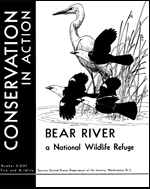United States Fish and Wildlife Service

United States Fish and Wildlife Service: Publications
Date of this Version
2000
Abstract
Marais des Cygnes National Wildlife Refuge (Refuge) was added to the National Wildlife Refuge system in 1992. The Refuge occupies approximately 2,550 ha of bottomland hardwoods habitats along the Marais des Cygnes River in Linn County, Kansas.
During public involvement in acquisition planning, the Service committed to opening the Refuge to recreational fishing. There are several water bodies on the Refuge which would provide recreational fishing opportunities. These include abandoned coal strip mines, small man-made farm ponds, and the Marais des Cygnes River and several tributaries to the river. Fish have been established in the coal mine and farm ponds either through human stocking efforts or by occasional flooding by the Marais des Cygnes River. As part of the obligation to provide safe recreational opportunities, an investigation of fish tissues was conducted to ensure that fish are not contaminated by heavy metals or other pollutants, and to establish that it is appropriate for the Service to open the Refuge to public fishing.
Previous efforts investigated contaminant concerns prior to acquisition of the Refuge (Allen and Nash 1992, Allen et al. 1995). These efforts showed no evidence of major contaminant concerns on the Refuge. However, the evaluations did not include all bodies of water on the Refuge that might be opened to fishing. The water in the impoundments originates from watersheds that extend beyond the boundaries of the Refuge, and, as a result, may be influenced by various land uses, including agricultural runoff, urban point and non-point sources, and unauthorized dumping. Other water bodies are fed by ground water, which also may be impacted by anthropogenic or natural sources.
Tissue samples collected in 1998 were analyzed for trace element, chlorinated hydrocarbon, and total petroleum hydrocarbon residue concentrations. While several contaminants were detected in many samples, none of the mean concentrations from any sample were sufficient to require creation of consumption advisories at the Refuge.


Comments
Published in Contaminant Report Number: R6/801M/1998, 1-37, (2000)